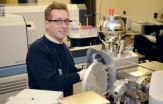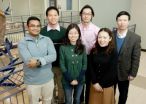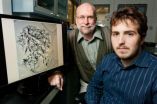(Press-News.org) In a study that the authors describe as lending credence to the idiom, "by the skin of your teeth," scientists are reporting that the protective shield fluoride forms on teeth is up to 100 times thinner than previously believed. It raises questions about how this renowned cavity-fighter really works and could lead to better ways of protecting teeth from decay, the scientists suggest. Their study appears in ACS' journal Langmuir.
Frank Müller and colleagues point out that tooth decay is a major public health problem worldwide. In the United States alone, consumers spend more than $50 billion each year on the treatment of cavities. The fluoride in some toothpaste, mouthwash and municipal drinking water is one of the most effective ways to prevent decay. Scientists long have known that fluoride makes enamel — the hard white substance covering the surface of teeth — more resistant to decay. Some thought that fluoride simply changed the main mineral in enamel, hydroxyapatite, into a more-decay resistant material called fluorapatite.
The new research found that the fluorapatite layer formed in this way is only 6 nanometers thick. It would take almost 10,000 such layers to span the width of a human hair. That's at least 10 times thinner than previous studies indicated. The scientists question whether a layer so thin, which is quickly worn away by ordinary chewing, really can shield teeth from decay, or whether fluoride has some other unrecognized effect on tooth enamel. They are launching a new study in search of an answer.
INFORMATION:
The authors acknowledge support from Deutsche Forschungsgemeinschaft and Saarland Ministry of Finances.
ARTICLE FOR IMMEDIATE RELEASE
"Elemental Depth Profiling of Fluoridated Hydroxyapatite: Saving Your Dentition by the Skin of Your Teeth?"
DOWNLOAD FULL TEXT ARTICLE
http://pubs.acs.org/stoken/presspac/presspac/full/10.1021/la102325e
CONTACT:
Frank Müller, Ph.D.
Experimental Physics
Saarland University
Saarbrücken, Germany
Phone: (0681) 302 - 704 79
Fax: (0681) 302 - 704 1999
Email: f.mueller@mx.uni-saarland.de
Does fluoride really fight cavities by 'the skin of the teeth?'
2010-12-16
ELSE PRESS RELEASES FROM THIS DATE:
Toxic toy crisis requires fresh solutions
2010-12-16
Manufacturer recalls of toys, promotional drinking glasses, and other children's products constitute an ongoing "toxic toys crisis" that requires banning potentially harmful ingredients in these products and other changes in policy and practices. That's the conclusion of a new analysis in ACS' journal Environmental Science & Technology.
Monica Becker, Sally Edwards and Rachel Massey note that in June the United States government recalled 12 million promotional drinking glasses sold at a fast-food restaurant chain because the painted coating contained cadmium, a toxic ...
Preteen conduct problems leads to teenage serious violence and delinquency
2010-12-16
Montreal, December 15, 2010 – Conduct disorders in preteens are predictive of eventual teenage serious violent and delinquent behavior, according to a new study from the Université de Montréal. The findings, published in this month's issue of Journal of Child Psychology and Psychiatry, have implications for concerned parents.
Preteens who steal, destroy property, fight and bully are six times as likely to sell illicit drugs, nine times as likely to join a gang, 11 times as likely to carry a weapon and eight times as likely to be arrested as a future teenager, according ...
Cilantro ingredient can remove foul odor of holiday chitlins
2010-12-16
With chitlins about to make their annual appearance on Christmas and New Year's Day menus, scientists have good news for millions of people who love that delicacy of down-home southern cooking, but hate the smell. They are reporting the first identification of an ingredient in cilantro that quashes the notoriously foul odor of chitlins — a smell known to drive people from the house when chitlins are cooking. Their report appears in ACS' Journal of Agricultural and Food Chemistry.
Yasuyoshi Hayata and colleagues note that chitlins — hog large intestines — are infamous ...
Bacterial life on and in humans orchestrates health and disease
2010-12-16
A mounting tide of scientific evidence suggests that the old adage from Aesop's fables — "You are known by the company you keep" — also applies to the trillions of microscopic bacteria and viruses that live on the human body. Humanity's invisible but constant companions — more bacteria hang out on the palms of your hands than there are people on Earth — is the topic of an article in the current edition of Chemical & Engineering News (C&EN), ACS' weekly newsmagazine.
C&EN Associate Editor Sarah Everts notes in the article that the astonishing diversity of microbes inhabiting ...
New discoveries make it harder for HIV to hide from drugs
2010-12-16
The virus that causes AIDS is chameleon-like in its replication. As HIV copies itself in humans, it constantly mutates into forms that can evade even the best cocktail of current therapies. Understanding exactly how HIV cells change as they reproduce is key to developing better tests and treatments for patients.
In the Journal of Biological Chemistry and Nature Structural & Molecular Biology, MU microbiologist and biochemist Stefan Sarafianos, PhD, reveals new findings that shed light on how HIV eludes treatment by mutating. His discoveries provide clues into HIV's mechanisms ...
Atomic weights of 10 elements on periodic table about to make an historic change
2010-12-16
For the first time in history, a change will be made to the atomic weights of some elements listed on the Periodic table of the chemical elements posted on walls of chemistry classrooms and on the inside covers of chemistry textbooks worldwide.
The new table, outlined in a report released this month, will express atomic weights of 10 elements - hydrogen, lithium, boron, carbon, nitrogen, oxygen, silicon, sulfur, chlorine and thallium - in a new manner that will reflect more accurately how these elements are found in nature.
"For more than a century and a half, many ...
Soft substrate promotes pluripotent stem cell culture
2010-12-16
CHAMPAIGN, Ill. — University of Illinois researchers have found a key to keeping stem cells in their neutral state: It takes a soft touch.
In a paper published in the journal PLoS One, the researchers demonstrated that culturing mouse embryonic stem cells (mESCs) on a soft gel rather than on a hard plate or dish keeps them in their pluripotent state, a ground state with the ability to become any type of tissue. The soft substrate maintains homogeneous pluripotent colonies over long periods of time – without the need for expensive growth chemicals.
"This has huge applications ...
Warning lights mark shellfish that aren't safe to eat
2010-12-16
Red tides and similar blooms can render some seafood unsafe to eat, though it can be difficult to tell whether a particular batch harbors toxins that cause food poisoning.
A new kind of marker developed by chemists at the University of California, San Diego, and reported in the journal ChemComm makes it easier to see if shellfish are filled with toxin-producing organisms.
Mussels and oysters accumulate single-celled marine creatures called dinoflagellates in their digestive systems as they filter seawater for food. Usually dinoflagellates are harmless, but sometimes ...
New method for making tiny catalysts holds promise for air quality
2010-12-16
CHAMPAIGN, Ill. — Fortified with iron: It's not just for breakfast cereal anymore. University of Illinois researchers have demonstrated a simpler method of adding iron to tiny carbon spheres to create catalytic materials that have the potential to remove contaminants from gas or liquid.
Civil and environmental engineering professor Mark Rood, graduate student John Atkinson and their team described their technique in the journal Carbon.
Carbon structures can be a support base for catalysts, such as iron and other metals. Iron is a readily available, low-cost catalyst ...
Researchers discover compound with potent effects on biological clock
2010-12-16
Using an automated screening technique developed by pharmaceutical companies to find new drugs, a team of researchers from UC San Diego and three other research institutions has discovered a molecule with the most potent effects ever seen on the biological clock.
Dubbed by the scientists "longdaysin," for its ability to dramatically slow down the biological clock, the new compound and the application of their screening method to the discovery of other clock-shifting chemicals could pave the way for a host of new drugs to treat severe sleep disorders or quickly reset the ...


